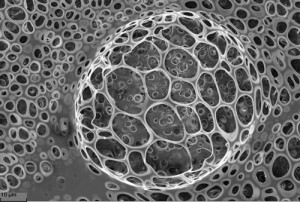The Hive was named the Research Image of the Year for 2011 by the Science Foundation of Ireland (SFI). From the Nov. 22, 2011 news item on Nanowerk,
The SFI Research Image competition offers SFI-funded researchers the opportunity to submit digital images created during the course of their research. The winning image was taken by Dr. David McGovern under supervision by Professor John Boland, CRANN’s [Center for Research on Adaptive Nanostructures and Nanodevices] Director and Principal Investigator from TCD’s [Trinity College of Dublin] School of Chemistry.
The image is of a porous surface of the polymer polylactic-co-glycolic acid (PLGA). From the Nov. 18, 2011 news release on the Trinity College website,
Porous polymers have the potential to deliver new biocompatible nanodevices or nanotemplates for medical applications and are of significance not only in the biomedical industry but also for materials science. CRANN’s research on porous polymers, during which the image was taken, has the potential to enable a wide variety of applications including therapeutic devices such as in implants, sutures, prosthetic devices and for drug delivery and wound care.
The image was produced using the Zeiss Auriga Focused Ion Beam (FIB) in CRANN’s Advanced Microscopy Laboratory (AML). The Auriga FIB is the only system in Europe and has the narrowest beam width of any such instrument on the market, enabling image resolution of less than 3 nanometres, approximately 30,000 times smaller than the width of one human hair.
Congratulations Dr. McGovern.
